Consumer Decision Making in Hospitality: An IHG Case Study
VerifiedAdded on 2021/02/19
|10
|3047
|37
Report
AI Summary
This report examines consumer behavior and decision-making processes within the hospitality industry, using Intercontinental Hotels Group (IHG) as a case study. It begins by outlining the customer decision-making journey, including need recognition, research, alternative analysis, pre-purchase, purchase, receive, and post-purchase stages. The report emphasizes the importance of understanding consumer behavior for marketers and differentiates between B2C and B2B decision-making processes. It evaluates various market research approaches and methods employed in decision-making, highlighting the role of marketers in responding to these processes with relevant examples. The report also explores factors influencing buying behavior, such as technology, cultural and sub-cultural influences, and applies relevant theories, concepts, and models to the context of hospitality decision-making. The analysis provides insights into how IHG can optimize its marketing strategies to meet customer expectations and enhance the overall customer experience. The report concludes with a summary of key findings and recommendations for the hospitality sector.
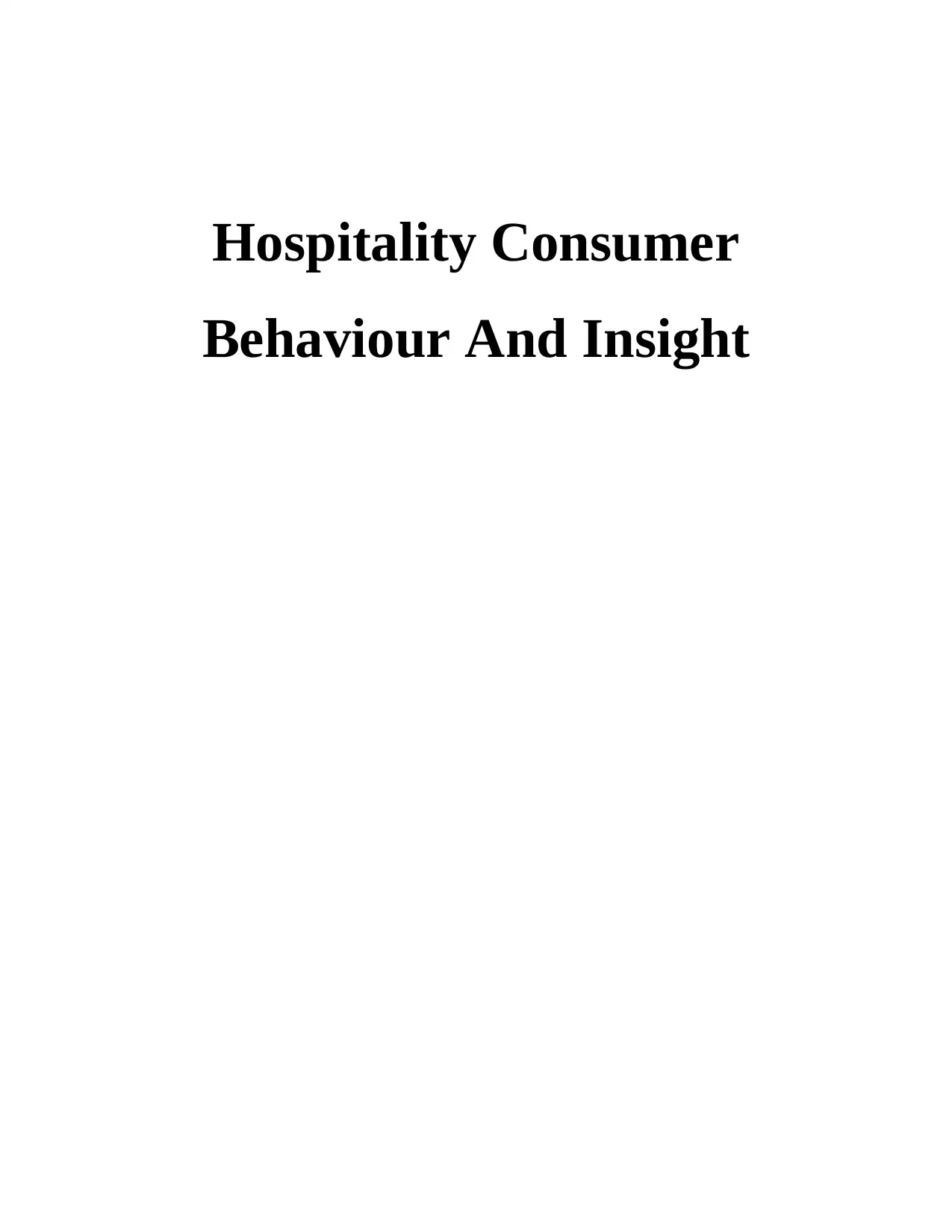
Hospitality Consumer
Behaviour And Insight
Behaviour And Insight
Paraphrase This Document
Need a fresh take? Get an instant paraphrase of this document with our AI Paraphraser
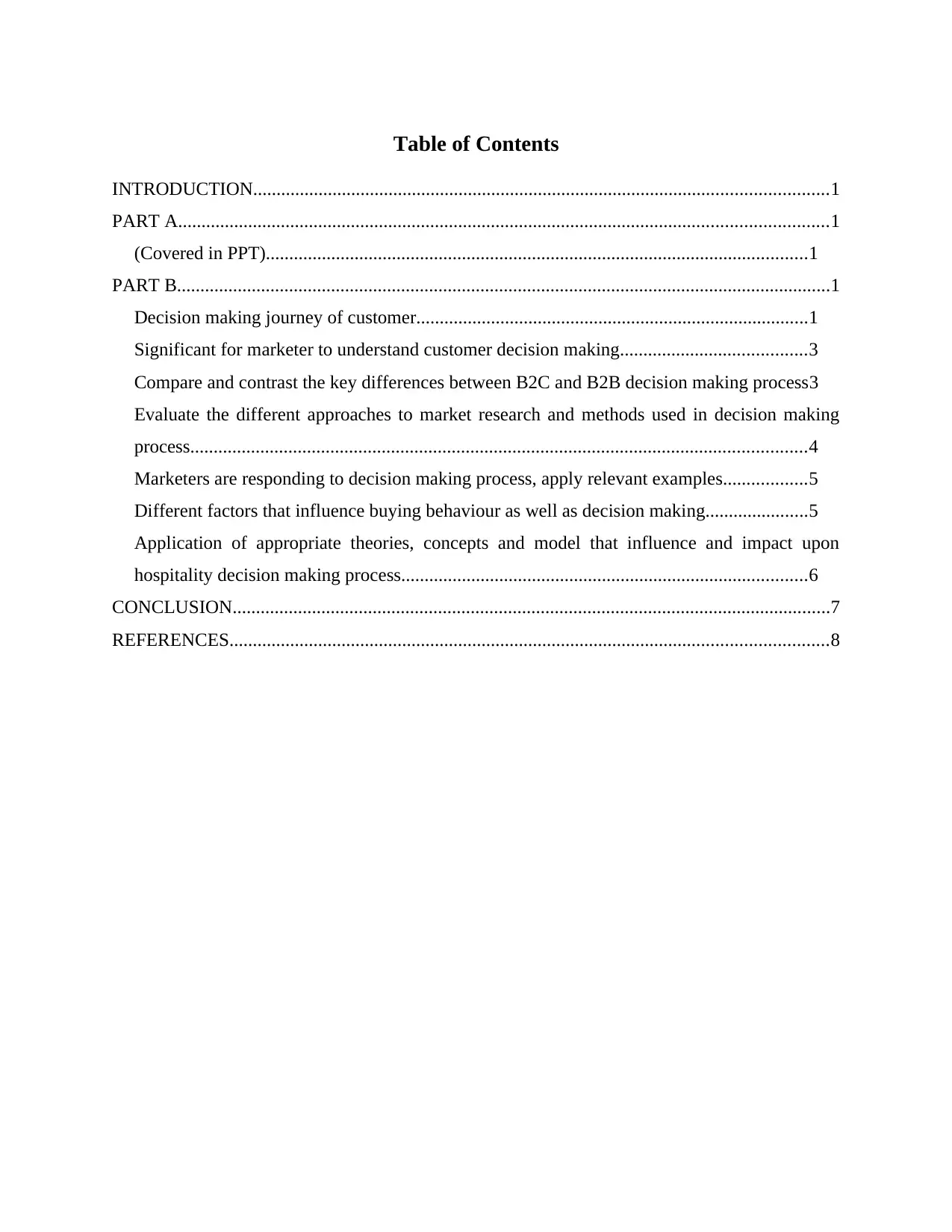
Table of Contents
INTRODUCTION...........................................................................................................................1
PART A...........................................................................................................................................1
(Covered in PPT)....................................................................................................................1
PART B............................................................................................................................................1
Decision making journey of customer....................................................................................1
Significant for marketer to understand customer decision making........................................3
Compare and contrast the key differences between B2C and B2B decision making process3
Evaluate the different approaches to market research and methods used in decision making
process....................................................................................................................................4
Marketers are responding to decision making process, apply relevant examples..................5
Different factors that influence buying behaviour as well as decision making......................5
Application of appropriate theories, concepts and model that influence and impact upon
hospitality decision making process.......................................................................................6
CONCLUSION................................................................................................................................7
REFERENCES................................................................................................................................8
INTRODUCTION...........................................................................................................................1
PART A...........................................................................................................................................1
(Covered in PPT)....................................................................................................................1
PART B............................................................................................................................................1
Decision making journey of customer....................................................................................1
Significant for marketer to understand customer decision making........................................3
Compare and contrast the key differences between B2C and B2B decision making process3
Evaluate the different approaches to market research and methods used in decision making
process....................................................................................................................................4
Marketers are responding to decision making process, apply relevant examples..................5
Different factors that influence buying behaviour as well as decision making......................5
Application of appropriate theories, concepts and model that influence and impact upon
hospitality decision making process.......................................................................................6
CONCLUSION................................................................................................................................7
REFERENCES................................................................................................................................8
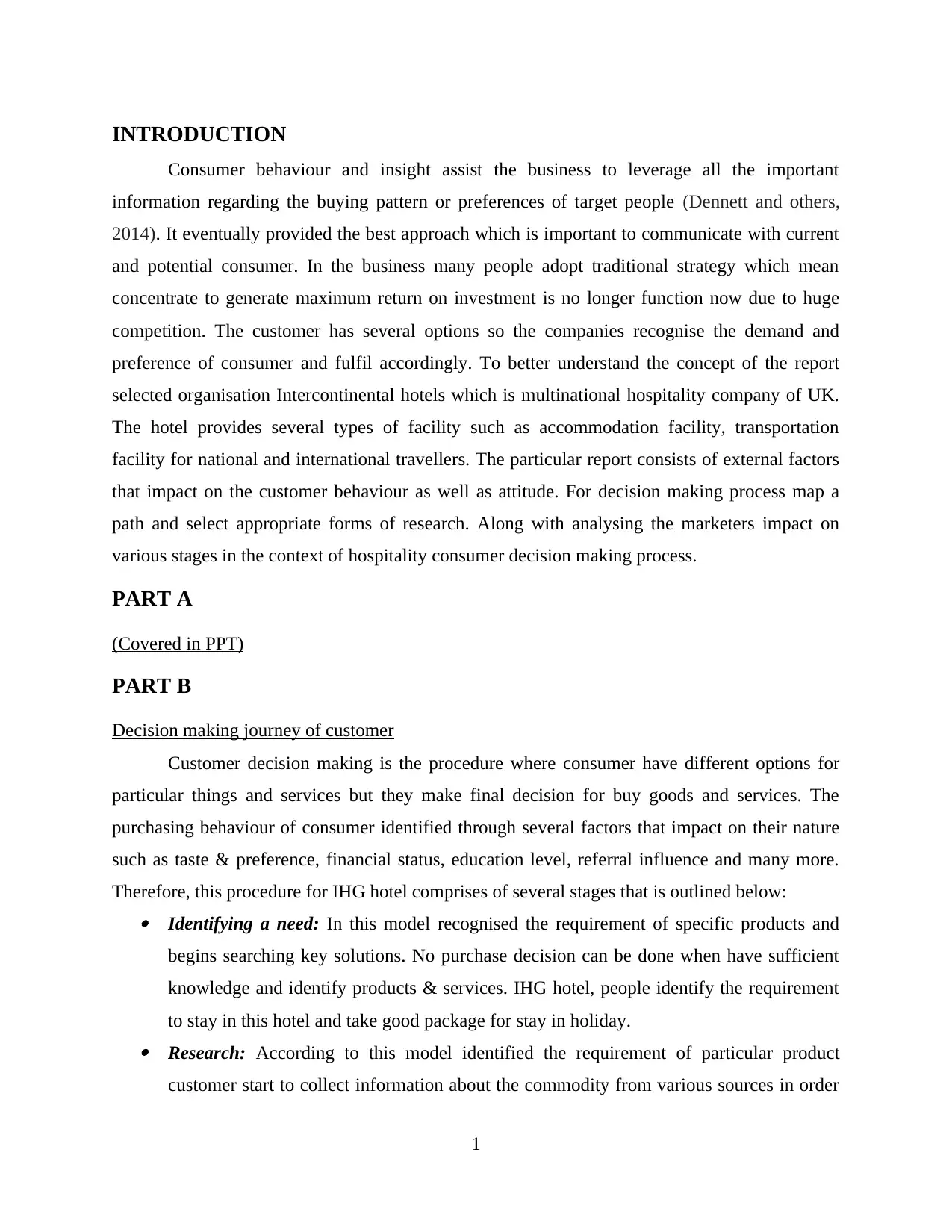
INTRODUCTION
Consumer behaviour and insight assist the business to leverage all the important
information regarding the buying pattern or preferences of target people (Dennett and others,
2014). It eventually provided the best approach which is important to communicate with current
and potential consumer. In the business many people adopt traditional strategy which mean
concentrate to generate maximum return on investment is no longer function now due to huge
competition. The customer has several options so the companies recognise the demand and
preference of consumer and fulfil accordingly. To better understand the concept of the report
selected organisation Intercontinental hotels which is multinational hospitality company of UK.
The hotel provides several types of facility such as accommodation facility, transportation
facility for national and international travellers. The particular report consists of external factors
that impact on the customer behaviour as well as attitude. For decision making process map a
path and select appropriate forms of research. Along with analysing the marketers impact on
various stages in the context of hospitality consumer decision making process.
PART A
(Covered in PPT)
PART B
Decision making journey of customer
Customer decision making is the procedure where consumer have different options for
particular things and services but they make final decision for buy goods and services. The
purchasing behaviour of consumer identified through several factors that impact on their nature
such as taste & preference, financial status, education level, referral influence and many more.
Therefore, this procedure for IHG hotel comprises of several stages that is outlined below: Identifying a need: In this model recognised the requirement of specific products and
begins searching key solutions. No purchase decision can be done when have sufficient
knowledge and identify products & services. IHG hotel, people identify the requirement
to stay in this hotel and take good package for stay in holiday. Research: According to this model identified the requirement of particular product
customer start to collect information about the commodity from various sources in order
1
Consumer behaviour and insight assist the business to leverage all the important
information regarding the buying pattern or preferences of target people (Dennett and others,
2014). It eventually provided the best approach which is important to communicate with current
and potential consumer. In the business many people adopt traditional strategy which mean
concentrate to generate maximum return on investment is no longer function now due to huge
competition. The customer has several options so the companies recognise the demand and
preference of consumer and fulfil accordingly. To better understand the concept of the report
selected organisation Intercontinental hotels which is multinational hospitality company of UK.
The hotel provides several types of facility such as accommodation facility, transportation
facility for national and international travellers. The particular report consists of external factors
that impact on the customer behaviour as well as attitude. For decision making process map a
path and select appropriate forms of research. Along with analysing the marketers impact on
various stages in the context of hospitality consumer decision making process.
PART A
(Covered in PPT)
PART B
Decision making journey of customer
Customer decision making is the procedure where consumer have different options for
particular things and services but they make final decision for buy goods and services. The
purchasing behaviour of consumer identified through several factors that impact on their nature
such as taste & preference, financial status, education level, referral influence and many more.
Therefore, this procedure for IHG hotel comprises of several stages that is outlined below: Identifying a need: In this model recognised the requirement of specific products and
begins searching key solutions. No purchase decision can be done when have sufficient
knowledge and identify products & services. IHG hotel, people identify the requirement
to stay in this hotel and take good package for stay in holiday. Research: According to this model identified the requirement of particular product
customer start to collect information about the commodity from various sources in order
1
⊘ This is a preview!⊘
Do you want full access?
Subscribe today to unlock all pages.

Trusted by 1+ million students worldwide
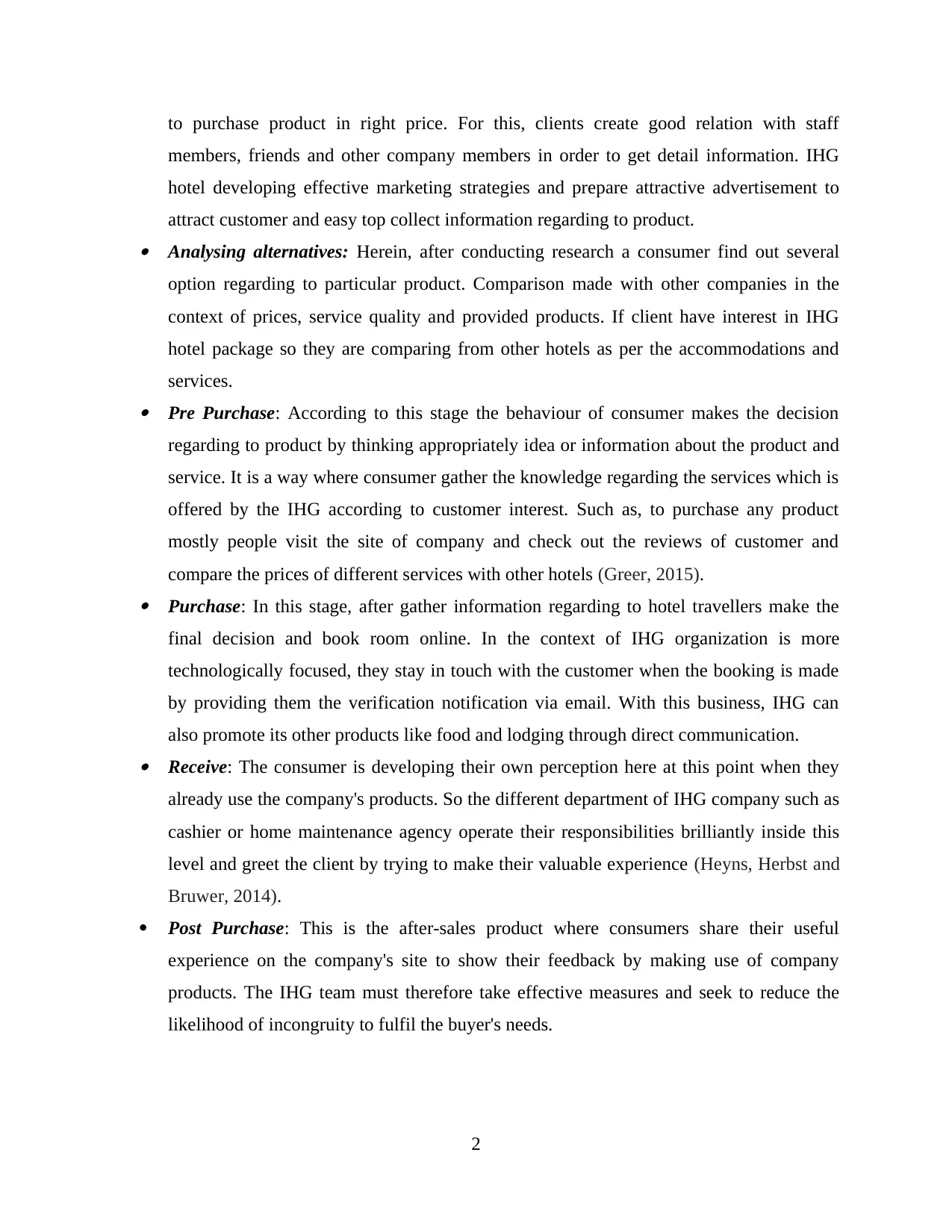
to purchase product in right price. For this, clients create good relation with staff
members, friends and other company members in order to get detail information. IHG
hotel developing effective marketing strategies and prepare attractive advertisement to
attract customer and easy top collect information regarding to product. Analysing alternatives: Herein, after conducting research a consumer find out several
option regarding to particular product. Comparison made with other companies in the
context of prices, service quality and provided products. If client have interest in IHG
hotel package so they are comparing from other hotels as per the accommodations and
services. Pre Purchase: According to this stage the behaviour of consumer makes the decision
regarding to product by thinking appropriately idea or information about the product and
service. It is a way where consumer gather the knowledge regarding the services which is
offered by the IHG according to customer interest. Such as, to purchase any product
mostly people visit the site of company and check out the reviews of customer and
compare the prices of different services with other hotels (Greer, 2015). Purchase: In this stage, after gather information regarding to hotel travellers make the
final decision and book room online. In the context of IHG organization is more
technologically focused, they stay in touch with the customer when the booking is made
by providing them the verification notification via email. With this business, IHG can
also promote its other products like food and lodging through direct communication. Receive: The consumer is developing their own perception here at this point when they
already use the company's products. So the different department of IHG company such as
cashier or home maintenance agency operate their responsibilities brilliantly inside this
level and greet the client by trying to make their valuable experience (Heyns, Herbst and
Bruwer, 2014).
Post Purchase: This is the after-sales product where consumers share their useful
experience on the company's site to show their feedback by making use of company
products. The IHG team must therefore take effective measures and seek to reduce the
likelihood of incongruity to fulfil the buyer's needs.
2
members, friends and other company members in order to get detail information. IHG
hotel developing effective marketing strategies and prepare attractive advertisement to
attract customer and easy top collect information regarding to product. Analysing alternatives: Herein, after conducting research a consumer find out several
option regarding to particular product. Comparison made with other companies in the
context of prices, service quality and provided products. If client have interest in IHG
hotel package so they are comparing from other hotels as per the accommodations and
services. Pre Purchase: According to this stage the behaviour of consumer makes the decision
regarding to product by thinking appropriately idea or information about the product and
service. It is a way where consumer gather the knowledge regarding the services which is
offered by the IHG according to customer interest. Such as, to purchase any product
mostly people visit the site of company and check out the reviews of customer and
compare the prices of different services with other hotels (Greer, 2015). Purchase: In this stage, after gather information regarding to hotel travellers make the
final decision and book room online. In the context of IHG organization is more
technologically focused, they stay in touch with the customer when the booking is made
by providing them the verification notification via email. With this business, IHG can
also promote its other products like food and lodging through direct communication. Receive: The consumer is developing their own perception here at this point when they
already use the company's products. So the different department of IHG company such as
cashier or home maintenance agency operate their responsibilities brilliantly inside this
level and greet the client by trying to make their valuable experience (Heyns, Herbst and
Bruwer, 2014).
Post Purchase: This is the after-sales product where consumers share their useful
experience on the company's site to show their feedback by making use of company
products. The IHG team must therefore take effective measures and seek to reduce the
likelihood of incongruity to fulfil the buyer's needs.
2
Paraphrase This Document
Need a fresh take? Get an instant paraphrase of this document with our AI Paraphraser
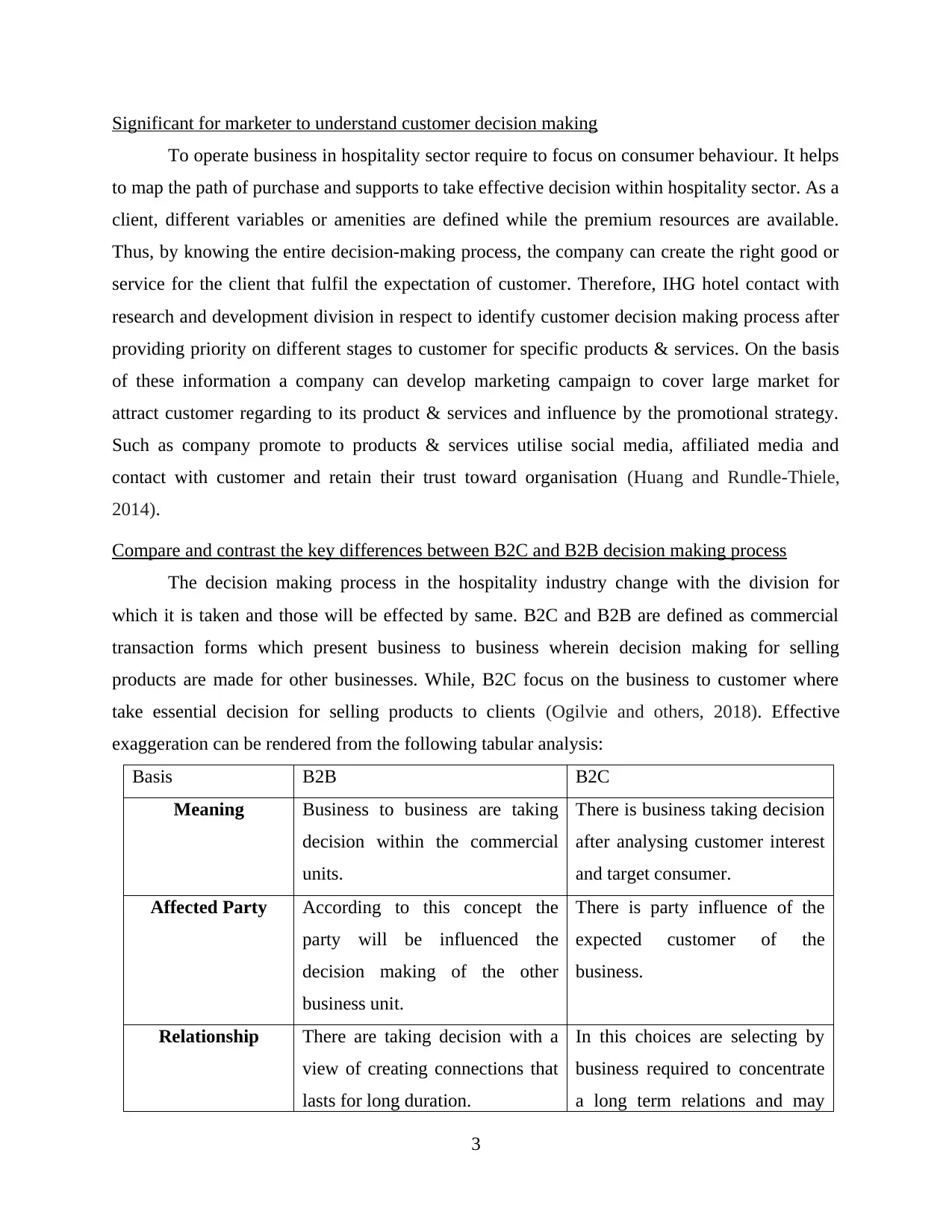
Significant for marketer to understand customer decision making
To operate business in hospitality sector require to focus on consumer behaviour. It helps
to map the path of purchase and supports to take effective decision within hospitality sector. As a
client, different variables or amenities are defined while the premium resources are available.
Thus, by knowing the entire decision-making process, the company can create the right good or
service for the client that fulfil the expectation of customer. Therefore, IHG hotel contact with
research and development division in respect to identify customer decision making process after
providing priority on different stages to customer for specific products & services. On the basis
of these information a company can develop marketing campaign to cover large market for
attract customer regarding to its product & services and influence by the promotional strategy.
Such as company promote to products & services utilise social media, affiliated media and
contact with customer and retain their trust toward organisation (Huang and Rundle-Thiele,
2014).
Compare and contrast the key differences between B2C and B2B decision making process
The decision making process in the hospitality industry change with the division for
which it is taken and those will be effected by same. B2C and B2B are defined as commercial
transaction forms which present business to business wherein decision making for selling
products are made for other businesses. While, B2C focus on the business to customer where
take essential decision for selling products to clients (Ogilvie and others, 2018). Effective
exaggeration can be rendered from the following tabular analysis:
Basis B2B B2C
Meaning Business to business are taking
decision within the commercial
units.
There is business taking decision
after analysing customer interest
and target consumer.
Affected Party According to this concept the
party will be influenced the
decision making of the other
business unit.
There is party influence of the
expected customer of the
business.
Relationship There are taking decision with a
view of creating connections that
lasts for long duration.
In this choices are selecting by
business required to concentrate
a long term relations and may
3
To operate business in hospitality sector require to focus on consumer behaviour. It helps
to map the path of purchase and supports to take effective decision within hospitality sector. As a
client, different variables or amenities are defined while the premium resources are available.
Thus, by knowing the entire decision-making process, the company can create the right good or
service for the client that fulfil the expectation of customer. Therefore, IHG hotel contact with
research and development division in respect to identify customer decision making process after
providing priority on different stages to customer for specific products & services. On the basis
of these information a company can develop marketing campaign to cover large market for
attract customer regarding to its product & services and influence by the promotional strategy.
Such as company promote to products & services utilise social media, affiliated media and
contact with customer and retain their trust toward organisation (Huang and Rundle-Thiele,
2014).
Compare and contrast the key differences between B2C and B2B decision making process
The decision making process in the hospitality industry change with the division for
which it is taken and those will be effected by same. B2C and B2B are defined as commercial
transaction forms which present business to business wherein decision making for selling
products are made for other businesses. While, B2C focus on the business to customer where
take essential decision for selling products to clients (Ogilvie and others, 2018). Effective
exaggeration can be rendered from the following tabular analysis:
Basis B2B B2C
Meaning Business to business are taking
decision within the commercial
units.
There is business taking decision
after analysing customer interest
and target consumer.
Affected Party According to this concept the
party will be influenced the
decision making of the other
business unit.
There is party influence of the
expected customer of the
business.
Relationship There are taking decision with a
view of creating connections that
lasts for long duration.
In this choices are selecting by
business required to concentrate
a long term relations and may
3
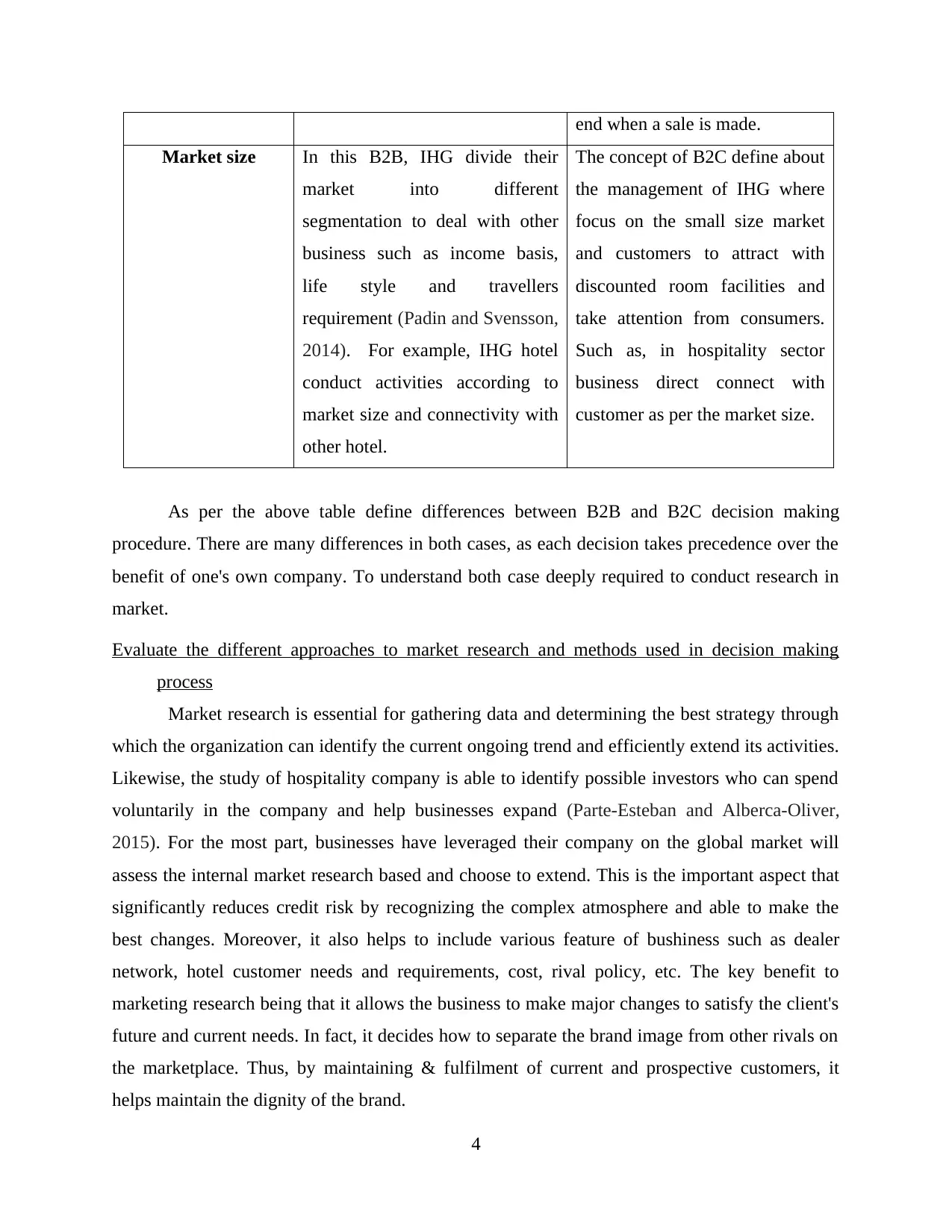
end when a sale is made.
Market size In this B2B, IHG divide their
market into different
segmentation to deal with other
business such as income basis,
life style and travellers
requirement (Padin and Svensson,
2014). For example, IHG hotel
conduct activities according to
market size and connectivity with
other hotel.
The concept of B2C define about
the management of IHG where
focus on the small size market
and customers to attract with
discounted room facilities and
take attention from consumers.
Such as, in hospitality sector
business direct connect with
customer as per the market size.
As per the above table define differences between B2B and B2C decision making
procedure. There are many differences in both cases, as each decision takes precedence over the
benefit of one's own company. To understand both case deeply required to conduct research in
market.
Evaluate the different approaches to market research and methods used in decision making
process
Market research is essential for gathering data and determining the best strategy through
which the organization can identify the current ongoing trend and efficiently extend its activities.
Likewise, the study of hospitality company is able to identify possible investors who can spend
voluntarily in the company and help businesses expand (Parte-Esteban and Alberca-Oliver,
2015). For the most part, businesses have leveraged their company on the global market will
assess the internal market research based and choose to extend. This is the important aspect that
significantly reduces credit risk by recognizing the complex atmosphere and able to make the
best changes. Moreover, it also helps to include various feature of bushiness such as dealer
network, hotel customer needs and requirements, cost, rival policy, etc. The key benefit to
marketing research being that it allows the business to make major changes to satisfy the client's
future and current needs. In fact, it decides how to separate the brand image from other rivals on
the marketplace. Thus, by maintaining & fulfilment of current and prospective customers, it
helps maintain the dignity of the brand.
4
Market size In this B2B, IHG divide their
market into different
segmentation to deal with other
business such as income basis,
life style and travellers
requirement (Padin and Svensson,
2014). For example, IHG hotel
conduct activities according to
market size and connectivity with
other hotel.
The concept of B2C define about
the management of IHG where
focus on the small size market
and customers to attract with
discounted room facilities and
take attention from consumers.
Such as, in hospitality sector
business direct connect with
customer as per the market size.
As per the above table define differences between B2B and B2C decision making
procedure. There are many differences in both cases, as each decision takes precedence over the
benefit of one's own company. To understand both case deeply required to conduct research in
market.
Evaluate the different approaches to market research and methods used in decision making
process
Market research is essential for gathering data and determining the best strategy through
which the organization can identify the current ongoing trend and efficiently extend its activities.
Likewise, the study of hospitality company is able to identify possible investors who can spend
voluntarily in the company and help businesses expand (Parte-Esteban and Alberca-Oliver,
2015). For the most part, businesses have leveraged their company on the global market will
assess the internal market research based and choose to extend. This is the important aspect that
significantly reduces credit risk by recognizing the complex atmosphere and able to make the
best changes. Moreover, it also helps to include various feature of bushiness such as dealer
network, hotel customer needs and requirements, cost, rival policy, etc. The key benefit to
marketing research being that it allows the business to make major changes to satisfy the client's
future and current needs. In fact, it decides how to separate the brand image from other rivals on
the marketplace. Thus, by maintaining & fulfilment of current and prospective customers, it
helps maintain the dignity of the brand.
4
⊘ This is a preview!⊘
Do you want full access?
Subscribe today to unlock all pages.

Trusted by 1+ million students worldwide
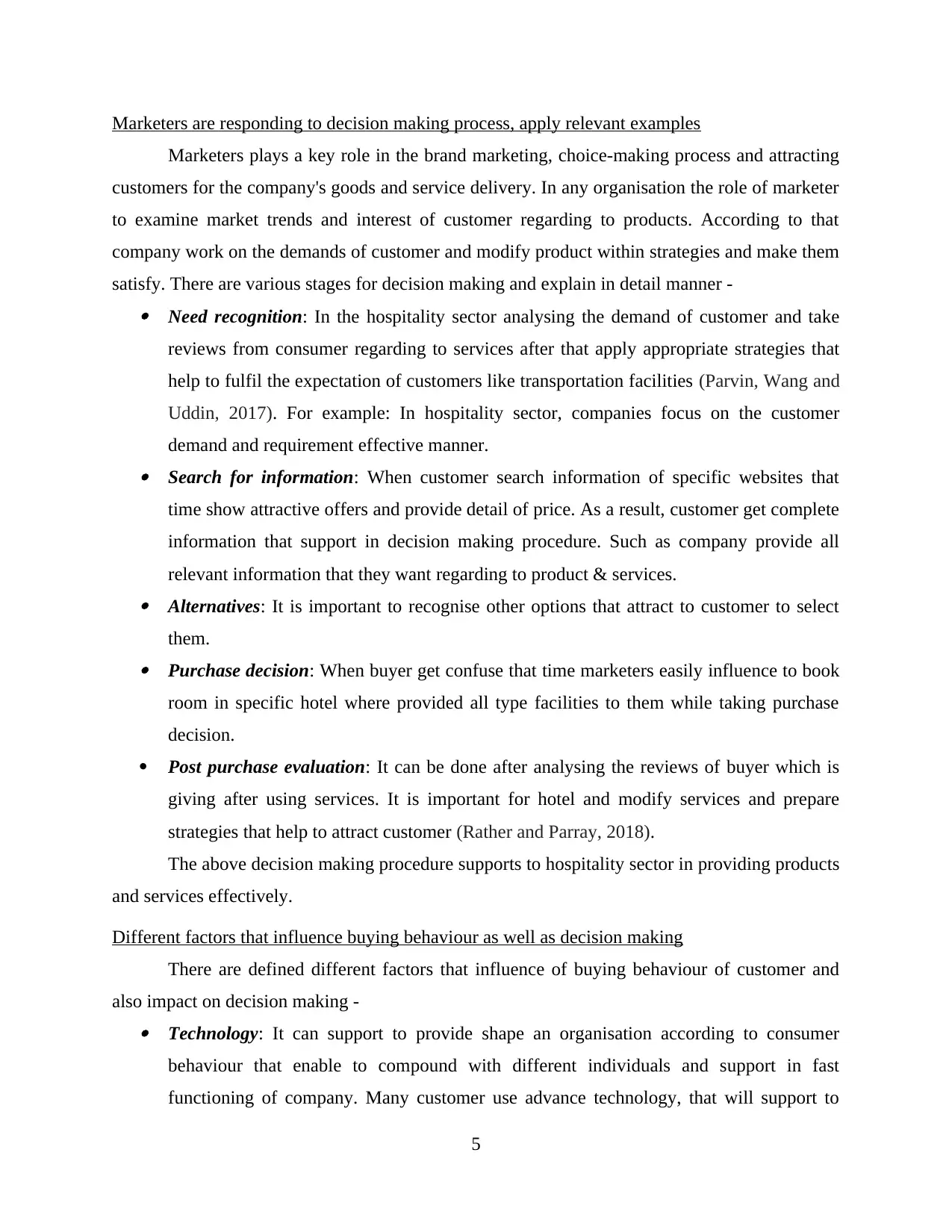
Marketers are responding to decision making process, apply relevant examples
Marketers plays a key role in the brand marketing, choice-making process and attracting
customers for the company's goods and service delivery. In any organisation the role of marketer
to examine market trends and interest of customer regarding to products. According to that
company work on the demands of customer and modify product within strategies and make them
satisfy. There are various stages for decision making and explain in detail manner - Need recognition: In the hospitality sector analysing the demand of customer and take
reviews from consumer regarding to services after that apply appropriate strategies that
help to fulfil the expectation of customers like transportation facilities (Parvin, Wang and
Uddin, 2017). For example: In hospitality sector, companies focus on the customer
demand and requirement effective manner. Search for information: When customer search information of specific websites that
time show attractive offers and provide detail of price. As a result, customer get complete
information that support in decision making procedure. Such as company provide all
relevant information that they want regarding to product & services. Alternatives: It is important to recognise other options that attract to customer to select
them. Purchase decision: When buyer get confuse that time marketers easily influence to book
room in specific hotel where provided all type facilities to them while taking purchase
decision.
Post purchase evaluation: It can be done after analysing the reviews of buyer which is
giving after using services. It is important for hotel and modify services and prepare
strategies that help to attract customer (Rather and Parray, 2018).
The above decision making procedure supports to hospitality sector in providing products
and services effectively.
Different factors that influence buying behaviour as well as decision making
There are defined different factors that influence of buying behaviour of customer and
also impact on decision making - Technology: It can support to provide shape an organisation according to consumer
behaviour that enable to compound with different individuals and support in fast
functioning of company. Many customer use advance technology, that will support to
5
Marketers plays a key role in the brand marketing, choice-making process and attracting
customers for the company's goods and service delivery. In any organisation the role of marketer
to examine market trends and interest of customer regarding to products. According to that
company work on the demands of customer and modify product within strategies and make them
satisfy. There are various stages for decision making and explain in detail manner - Need recognition: In the hospitality sector analysing the demand of customer and take
reviews from consumer regarding to services after that apply appropriate strategies that
help to fulfil the expectation of customers like transportation facilities (Parvin, Wang and
Uddin, 2017). For example: In hospitality sector, companies focus on the customer
demand and requirement effective manner. Search for information: When customer search information of specific websites that
time show attractive offers and provide detail of price. As a result, customer get complete
information that support in decision making procedure. Such as company provide all
relevant information that they want regarding to product & services. Alternatives: It is important to recognise other options that attract to customer to select
them. Purchase decision: When buyer get confuse that time marketers easily influence to book
room in specific hotel where provided all type facilities to them while taking purchase
decision.
Post purchase evaluation: It can be done after analysing the reviews of buyer which is
giving after using services. It is important for hotel and modify services and prepare
strategies that help to attract customer (Rather and Parray, 2018).
The above decision making procedure supports to hospitality sector in providing products
and services effectively.
Different factors that influence buying behaviour as well as decision making
There are defined different factors that influence of buying behaviour of customer and
also impact on decision making - Technology: It can support to provide shape an organisation according to consumer
behaviour that enable to compound with different individuals and support in fast
functioning of company. Many customer use advance technology, that will support to
5
Paraphrase This Document
Need a fresh take? Get an instant paraphrase of this document with our AI Paraphraser
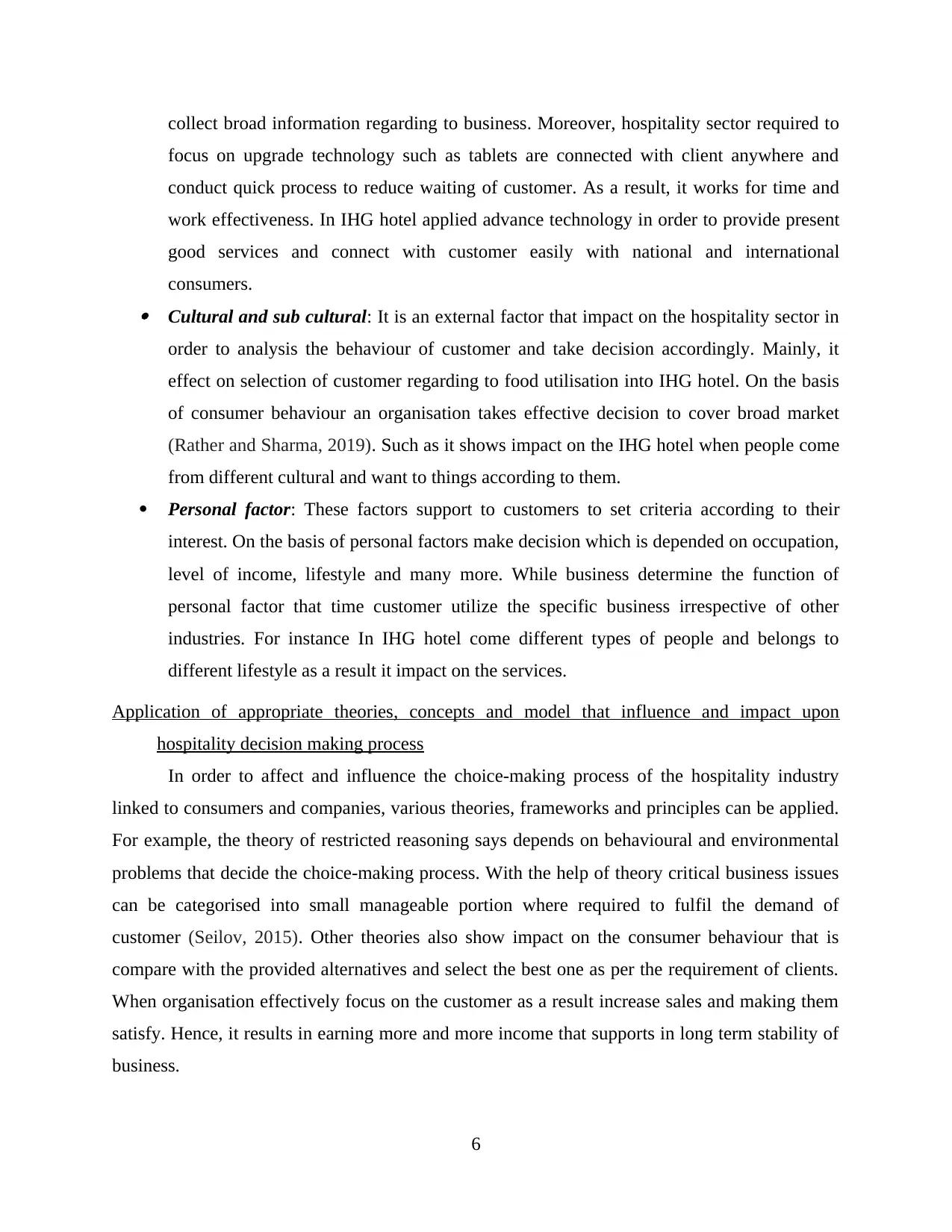
collect broad information regarding to business. Moreover, hospitality sector required to
focus on upgrade technology such as tablets are connected with client anywhere and
conduct quick process to reduce waiting of customer. As a result, it works for time and
work effectiveness. In IHG hotel applied advance technology in order to provide present
good services and connect with customer easily with national and international
consumers. Cultural and sub cultural: It is an external factor that impact on the hospitality sector in
order to analysis the behaviour of customer and take decision accordingly. Mainly, it
effect on selection of customer regarding to food utilisation into IHG hotel. On the basis
of consumer behaviour an organisation takes effective decision to cover broad market
(Rather and Sharma, 2019). Such as it shows impact on the IHG hotel when people come
from different cultural and want to things according to them.
Personal factor: These factors support to customers to set criteria according to their
interest. On the basis of personal factors make decision which is depended on occupation,
level of income, lifestyle and many more. While business determine the function of
personal factor that time customer utilize the specific business irrespective of other
industries. For instance In IHG hotel come different types of people and belongs to
different lifestyle as a result it impact on the services.
Application of appropriate theories, concepts and model that influence and impact upon
hospitality decision making process
In order to affect and influence the choice-making process of the hospitality industry
linked to consumers and companies, various theories, frameworks and principles can be applied.
For example, the theory of restricted reasoning says depends on behavioural and environmental
problems that decide the choice-making process. With the help of theory critical business issues
can be categorised into small manageable portion where required to fulfil the demand of
customer (Seilov, 2015). Other theories also show impact on the consumer behaviour that is
compare with the provided alternatives and select the best one as per the requirement of clients.
When organisation effectively focus on the customer as a result increase sales and making them
satisfy. Hence, it results in earning more and more income that supports in long term stability of
business.
6
focus on upgrade technology such as tablets are connected with client anywhere and
conduct quick process to reduce waiting of customer. As a result, it works for time and
work effectiveness. In IHG hotel applied advance technology in order to provide present
good services and connect with customer easily with national and international
consumers. Cultural and sub cultural: It is an external factor that impact on the hospitality sector in
order to analysis the behaviour of customer and take decision accordingly. Mainly, it
effect on selection of customer regarding to food utilisation into IHG hotel. On the basis
of consumer behaviour an organisation takes effective decision to cover broad market
(Rather and Sharma, 2019). Such as it shows impact on the IHG hotel when people come
from different cultural and want to things according to them.
Personal factor: These factors support to customers to set criteria according to their
interest. On the basis of personal factors make decision which is depended on occupation,
level of income, lifestyle and many more. While business determine the function of
personal factor that time customer utilize the specific business irrespective of other
industries. For instance In IHG hotel come different types of people and belongs to
different lifestyle as a result it impact on the services.
Application of appropriate theories, concepts and model that influence and impact upon
hospitality decision making process
In order to affect and influence the choice-making process of the hospitality industry
linked to consumers and companies, various theories, frameworks and principles can be applied.
For example, the theory of restricted reasoning says depends on behavioural and environmental
problems that decide the choice-making process. With the help of theory critical business issues
can be categorised into small manageable portion where required to fulfil the demand of
customer (Seilov, 2015). Other theories also show impact on the consumer behaviour that is
compare with the provided alternatives and select the best one as per the requirement of clients.
When organisation effectively focus on the customer as a result increase sales and making them
satisfy. Hence, it results in earning more and more income that supports in long term stability of
business.
6
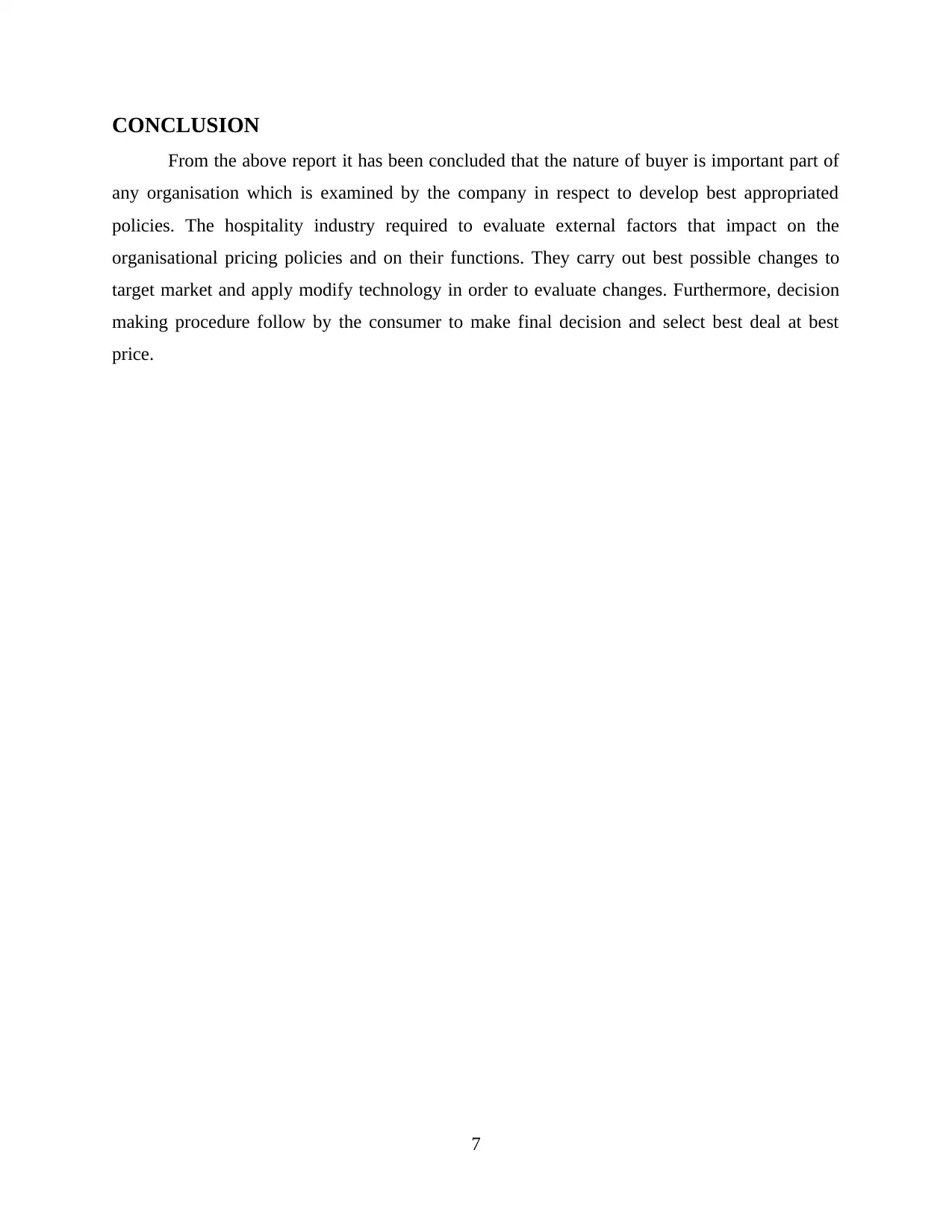
CONCLUSION
From the above report it has been concluded that the nature of buyer is important part of
any organisation which is examined by the company in respect to develop best appropriated
policies. The hospitality industry required to evaluate external factors that impact on the
organisational pricing policies and on their functions. They carry out best possible changes to
target market and apply modify technology in order to evaluate changes. Furthermore, decision
making procedure follow by the consumer to make final decision and select best deal at best
price.
7
From the above report it has been concluded that the nature of buyer is important part of
any organisation which is examined by the company in respect to develop best appropriated
policies. The hospitality industry required to evaluate external factors that impact on the
organisational pricing policies and on their functions. They carry out best possible changes to
target market and apply modify technology in order to evaluate changes. Furthermore, decision
making procedure follow by the consumer to make final decision and select best deal at best
price.
7
⊘ This is a preview!⊘
Do you want full access?
Subscribe today to unlock all pages.

Trusted by 1+ million students worldwide
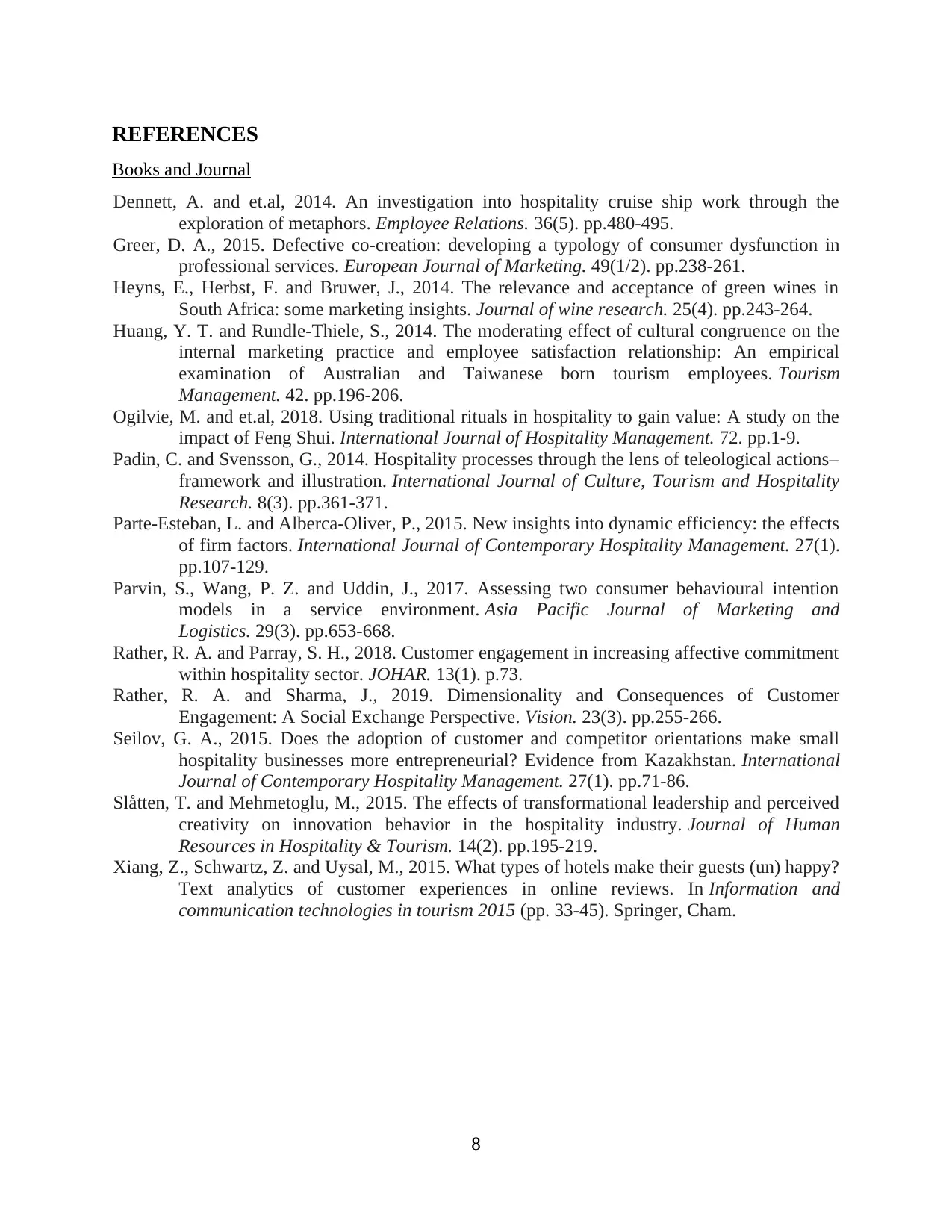
REFERENCES
Books and Journal
Dennett, A. and et.al, 2014. An investigation into hospitality cruise ship work through the
exploration of metaphors. Employee Relations. 36(5). pp.480-495.
Greer, D. A., 2015. Defective co-creation: developing a typology of consumer dysfunction in
professional services. European Journal of Marketing. 49(1/2). pp.238-261.
Heyns, E., Herbst, F. and Bruwer, J., 2014. The relevance and acceptance of green wines in
South Africa: some marketing insights. Journal of wine research. 25(4). pp.243-264.
Huang, Y. T. and Rundle-Thiele, S., 2014. The moderating effect of cultural congruence on the
internal marketing practice and employee satisfaction relationship: An empirical
examination of Australian and Taiwanese born tourism employees. Tourism
Management. 42. pp.196-206.
Ogilvie, M. and et.al, 2018. Using traditional rituals in hospitality to gain value: A study on the
impact of Feng Shui. International Journal of Hospitality Management. 72. pp.1-9.
Padin, C. and Svensson, G., 2014. Hospitality processes through the lens of teleological actions–
framework and illustration. International Journal of Culture, Tourism and Hospitality
Research. 8(3). pp.361-371.
Parte-Esteban, L. and Alberca-Oliver, P., 2015. New insights into dynamic efficiency: the effects
of firm factors. International Journal of Contemporary Hospitality Management. 27(1).
pp.107-129.
Parvin, S., Wang, P. Z. and Uddin, J., 2017. Assessing two consumer behavioural intention
models in a service environment. Asia Pacific Journal of Marketing and
Logistics. 29(3). pp.653-668.
Rather, R. A. and Parray, S. H., 2018. Customer engagement in increasing affective commitment
within hospitality sector. JOHAR. 13(1). p.73.
Rather, R. A. and Sharma, J., 2019. Dimensionality and Consequences of Customer
Engagement: A Social Exchange Perspective. Vision. 23(3). pp.255-266.
Seilov, G. A., 2015. Does the adoption of customer and competitor orientations make small
hospitality businesses more entrepreneurial? Evidence from Kazakhstan. International
Journal of Contemporary Hospitality Management. 27(1). pp.71-86.
Slåtten, T. and Mehmetoglu, M., 2015. The effects of transformational leadership and perceived
creativity on innovation behavior in the hospitality industry. Journal of Human
Resources in Hospitality & Tourism. 14(2). pp.195-219.
Xiang, Z., Schwartz, Z. and Uysal, M., 2015. What types of hotels make their guests (un) happy?
Text analytics of customer experiences in online reviews. In Information and
communication technologies in tourism 2015 (pp. 33-45). Springer, Cham.
8
Books and Journal
Dennett, A. and et.al, 2014. An investigation into hospitality cruise ship work through the
exploration of metaphors. Employee Relations. 36(5). pp.480-495.
Greer, D. A., 2015. Defective co-creation: developing a typology of consumer dysfunction in
professional services. European Journal of Marketing. 49(1/2). pp.238-261.
Heyns, E., Herbst, F. and Bruwer, J., 2014. The relevance and acceptance of green wines in
South Africa: some marketing insights. Journal of wine research. 25(4). pp.243-264.
Huang, Y. T. and Rundle-Thiele, S., 2014. The moderating effect of cultural congruence on the
internal marketing practice and employee satisfaction relationship: An empirical
examination of Australian and Taiwanese born tourism employees. Tourism
Management. 42. pp.196-206.
Ogilvie, M. and et.al, 2018. Using traditional rituals in hospitality to gain value: A study on the
impact of Feng Shui. International Journal of Hospitality Management. 72. pp.1-9.
Padin, C. and Svensson, G., 2014. Hospitality processes through the lens of teleological actions–
framework and illustration. International Journal of Culture, Tourism and Hospitality
Research. 8(3). pp.361-371.
Parte-Esteban, L. and Alberca-Oliver, P., 2015. New insights into dynamic efficiency: the effects
of firm factors. International Journal of Contemporary Hospitality Management. 27(1).
pp.107-129.
Parvin, S., Wang, P. Z. and Uddin, J., 2017. Assessing two consumer behavioural intention
models in a service environment. Asia Pacific Journal of Marketing and
Logistics. 29(3). pp.653-668.
Rather, R. A. and Parray, S. H., 2018. Customer engagement in increasing affective commitment
within hospitality sector. JOHAR. 13(1). p.73.
Rather, R. A. and Sharma, J., 2019. Dimensionality and Consequences of Customer
Engagement: A Social Exchange Perspective. Vision. 23(3). pp.255-266.
Seilov, G. A., 2015. Does the adoption of customer and competitor orientations make small
hospitality businesses more entrepreneurial? Evidence from Kazakhstan. International
Journal of Contemporary Hospitality Management. 27(1). pp.71-86.
Slåtten, T. and Mehmetoglu, M., 2015. The effects of transformational leadership and perceived
creativity on innovation behavior in the hospitality industry. Journal of Human
Resources in Hospitality & Tourism. 14(2). pp.195-219.
Xiang, Z., Schwartz, Z. and Uysal, M., 2015. What types of hotels make their guests (un) happy?
Text analytics of customer experiences in online reviews. In Information and
communication technologies in tourism 2015 (pp. 33-45). Springer, Cham.
8
1 out of 10
Related Documents
Your All-in-One AI-Powered Toolkit for Academic Success.
+13062052269
info@desklib.com
Available 24*7 on WhatsApp / Email
![[object Object]](/_next/static/media/star-bottom.7253800d.svg)
Unlock your academic potential
Copyright © 2020–2025 A2Z Services. All Rights Reserved. Developed and managed by ZUCOL.





